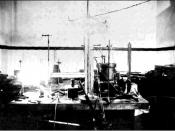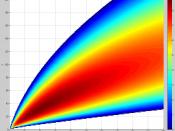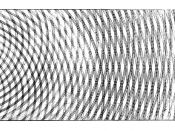Radioactivity
The discovery of nucleus- Rutherford scattering
Polonium: ñ emitter
The vast majority of ñ passed straight through either undeflected or deflected by a small angle: the atom must be mostly empty space
A small proportion of ñ were deflected through angles bigger than 90⦠and an even small proportion were deflected through 180â¦: there must be a very small point in the atom that has all of the positive charge and most of the mass
Could chamber
When ñ particles pass through the cool air saturated with ethanol vapour, they leave a trial. The air is ionised and the vapour condense around the ions forming the trial. Each trial is the same length, proving the source is emitting ñ particles.
The intensity of gamma radiation is the energy per second emitted from a source passing normally through a unit area (W/m2)
Activity: the number of decays per second on average (Bq)
The decay constant is the probability of a nucleus decaying per second (s-1)
Random nature of radioactive decay:
There is equal probability of any nucleus decaying, it cannot be known which particular nucleus will decay next, it cannot be known at what time a particular nucleus will decay, it is only possible to estimate the proportion of nuclei decaying in the next time interval.
The half-life is the time it takes for the number of active nuclei in a sample (activity) to drop to half of its original value
Why the isotope technetium-99 is often chosen as a suitable source of radiation for use in many medical diagnoses: it only emits gamma rays, and can be detected outside the body, it has a short enough half-life and will not remain active in the body after use, it has a long enough half-life to remain active during diagnosis
Mass difference: mass of nucleus is less than the total mass of the constituent nucleons
Binding energy: energy required to break up a nucleus into its separate nucleons/energy released when a nucleus is formed from separate nucleons
Binding energy per nucleon: the average energy that must be supplied to release a single nucleon from the nucleus
Nuclear fusion: two light nuclei combine to form a more massive one nucleus, as both nuclei are positively charged, electrostatic repulsion has to be overcome, nuclei have to be given kinetic energy for them to meet
Nuclear fission: a heavy nucleus splits into two smaller nuclei, neutrons are released
Induced fission: splitting of large nucleus into two smaller nuclei brought about by bombardment
Thermal neutrons: have low energies or speed e.g. 0.03eV
Self-sustaining chain reaction: fission reaction gives out neutrons from fission cause further fission, self-sustaining when one fission leads to at least one further fission
Critical mass of a fissile material is the minimum mass of it that will support a self-sustaining chain reaction
Why spent fuel rods present a greater radiation hazard: it is easy to stay out of range, most fission fragments are more radioactive and are initially most likely to be beta emitters, ionising radiation damage body tissue
Thermal physics
The internal energy of a substance is the sum of the potential and kinetic energies of all its particles.
The specific heat capacity of a material is the energy needed to cause a temperature rise of 1K in a mass of 1 kg
The specific latent heat of fusion of a substance is the energy required to change 1kg of a solid into 1kg of liquid with no change in temperature
The specific latent heat of vaporisation of a substance is the energy required to change 1kg of a liquid into 1kg gas with no change in temperature
The discovery of the electron
Discharge tube:
Why light was emitted: ions present are accelerated by electric field , excitation of gas atoms occur, photon emitted on return to lower energy to ground state
Why the glow was not observed until the pressure of the air in the tube was low enough: ions do not gain enough kinetic energy as they collide with air particles, also because too many atoms present
Electron gun:
Unit A: 6V, supply current to the filament and heats up the filament
Unit B: 2kV, to make the anode positive, so that the electrons are attracted to the anode
Reduce A: Beam current is reduced, because fewer electrons are emitted per sec from the filament as it become less hot; Increase B: electrons travel faster/ gain more kinetic energy, because the electrons are attracted toward the anode with greater acceleration
Thermionic emission: this is the emission of conduction electrons when they gain sufficient kinetic energy to overcome the work function of a heated wire
Why it is essential that the container is evacuated: electrons from wire can collide with gas atoms and lose kinetic energy/speed
Determining e/m:
Why the beam curves up at an increasing angle to the horizontal as an electron enter an electric field:
each electron experiences an electrostatic for vertically upwards,
this force does not change as the electron moves across the field,
therefore each electron has a constant acceleration vertically upward,
velocity of each electron has a constant horizontal component of velocity and has an increasing vertical component of velocity,
so the direction of motion become closer and closer to a vertical line
Why electrons move in a circular path at a constant speed in the magnetic field:
Magnetic force on each electron in the beam is perpendicular to velocity
No work is done on each electron by magnetic force so ke/speed is constant
Magnitude of magnetic force is constant because speed is constant
Magnetic force is always perpendicular to velocity so is centripetal
Value of specific charge of the electron compared with the specific charge of H+ ion:
Specific charge for the electron=2000 x specific charge of H+
Which was the largest known specific charge before the specific charge of the electron was determined
This is due to a much smaller mass of the electron
Millikan's oil drop experiment:
Why the droplet stopped moving when the potential difference between the plates was adjusted to Vc: force due to electric field is vertically upwards and is proportional to the potential difference between the plates, at V=Vc, force due to field is equal and opposite to the weight of the droplet, no resultant force at Vc
Why the initial acceleration of the droplet is equal to g: the viscous force is initially zero, resultant force = ma, a=g
Why a charged oil droplet reaches a constant speed:
Weight pulls droplet down, no electric fore to counteract weight, viscous force increases with speed, weight=viscous force at terminal speed
Millikan had discovered that the charge is quantised, the charge on each droplet is a whole number times 1.6 ÃÂ 10-19 C, the least amount of charge (or the quantum of charge) is the charge of electron
Wave particle duality
Young's double slit experiment:
Wave are emitted by each slit, each slit diffracts light
There are two coherent lights sources with constant phase difference and same frequency
They diffract through the gap and overlap with one another
Bright fringes formed where constructive interference happens, the path difference is whole number (n) of wavelengths
Dark fringes formed where destructive interference happens, the path difference is whole number + half wavelengths
Interference is a wave property
Since n is any whole number, more than two bright fringes are observed
Explain what Newton theory of light would predicts for the same experimental arrangement: light consists of corpuscles, corpuscles would not be diffracted, and only two bright fringes would be seen, dark fringes cannot happen with corpuscles
Use Newton's theory to explain refraction:
Light consists of corpuscles
They are attracted towards glass surface
Velocity normal to surface increase
Velocity parallel to surface unchanged
Huygens' theory considered light waves as longitudinal and hence could not explain polarisation and Newton's scientific reputation was more influential
Electromagnetic waves:
The electric and magnetic fields are in phase with one another, at right angles to each other, and at right angles to the direction of propagation of the wave
Explain why an alternating emf is induced in the loop:
Magnetic wave vibrate perpendicular to loop, causing alternating magnetic flux cutting through the loop, alternating magnetic flux induce an alternating emf
Photoelectric effect
There is a minimum frequency, called the threshold frequency below which it could not occur
The threshold frequency varies for different metal
The effect is instantaneous when the UV light hits the metal
The kinetic energy of the photoelectrons vary from zero up to a maximum
The maximum kinetic energy is dependent on the frequency of the light but not on the intensity
Light consists of photons, energy of a photon=hf
Minimum energy required for an electron to escape the metal surface is called the work function ÃÂ, an electron will be emitted if hf âÂÂ¥ÃÂ
Maximum kinetic energy=hf-ÃÂ
During the photoelectric effect, one photon interacts with one electron and transfers all its energy to it
Wave theory could not explain the observation:
Energy should be spread across the whole wavefront, meaning the electrons would each share a small proportion of the wave's energy, thus the effect would not instantaneous
All frequency of light should cause electrons to be emitted
Hence cannot explain why light below threshold frequency could not cause photoelectric emission
Electromagnetic radiation
Wave like nature-interference, young's double slit experiment
Particle like nature- photoelectric effect
Matter particles
Wave like nature-electron diffraction of a beam of electron by a thin metal sample
Particle like nature- electrons can be deflected by E and B fields
Transmission electron microscope
Condenser lens: produce a wide uniform parallel beam of electros
Objective lens: produce an intermediate, magnified image
Projector lens: further magifies the image and projects it onto the screen
The object needs to be very thin, so that the electrons do not slow down
Lens aberrations caused by electrons having a range of speed , lower resolution
Anode voltage decrease: If the speed decrease, the wave length of electron increase, larger wavelength produce more diffraction, so the resolution is decreased
Why it is important that the eletrons in the beam have the same speed: force on an electron in a magnetic field depends on speed, electrons at different speed would be focussed differently, image would blurred
Scanning tunnelling microscope
With a p.d., electrons transfer from - to + only, with zero p.d., equal transfer in either direction
Explain, interms of wave particle duality, why an electron can cross this small gap: electrons have wave-like nature, a wave can penetrate thin barriers/ tunnel across gap, probability of transfer of an electron negligible if gap is too wide
Constant height mode:
Tip height constant
Gap width varies as tis scams across at constant height
Current due to electron transfer is measured
Current decreases at gao with increases or vise versa
As tip moves across surface, variation of current with time is used to map surface
Constant current mode:
Height of probe tip changed to keep gap width constant
Tip height altered to keep current constant
Current due to electron transfer is measured
As tip moves across surface, variation of height of tio with time maps the surface
Special relativity
The Michelson-Morley experiment
Why interference fringes shift their position if the distance from either of the two mirrors to the smei-silvered glass block is changed: (Two beams reach the observer, inteference takes placebetween two beams) birght fringe is seen where the two beams are in phase, changing the distance to either mirror changes the path difference, so fringes shift
Rotate 90â¦:
Why is it predicted that a shift of the fringes would be observed:
Speed of light was through to depend on the speed of the light source
Distance travelled by each beam unchanged by rotation
Time difference between the two beams would change
Phase difference would therefore change (so fringes would shift)
Conclusion drawn:
Speed of light is independent of the speed of the light source
Ether hypothesis incorrect
Absolute motion does not exist
1st postulate: An inertial frame of reference is one which Newton's 1st law is valid
2nd postulate: the speed of light in free space is invariant: the speed of light in free space is constant and does not depend on the motion of the source or the observer


